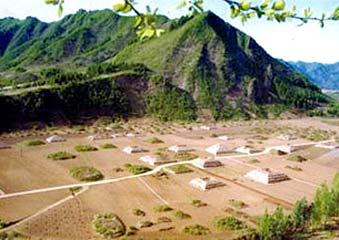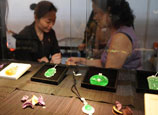
 |
| Capital Cities and Tombs of the Ancient Koguryo Kingdom (CNTV) |
Date of Inscription: 2004
Assessment of the World Heritage Committee
The Koguryo Relics is in accordance with five of the six standards for selecting world heritage. First, it is an outstanding accomplishment that can reflect the creativity and wisdom of mankind. Second, the capital cities and tombs can reflect the Han nationality’s cultural influence on other nationalities, and the relics contain many frescoes with distinctive characteristics. Third, it can reflect the lost Koguryo civilization. Fourth, the capital cities built with stones and mud in the Koguryo Dynasty had greatly affected future ages. Fifth, it is a perfect example of combining human creativity and nature.
Chinese name: Gao Ju Li Wang Cheng, Wang Ling Ji Gui Zu Mu Zang
English name: Capital Cities and Tombs of the Ancient Koguryo Kingdom
Based on the standard C for selecting cultural heritage, the Capital Cities and Tombs of the Ancient Koguryo Kingdom were listed in the World Heritage List in July 2004.
The Koguryo Kingdom began in 37 B.C. and ended in 668 A.D. It was once a very influential minority nationality regime in China’s northeastern region, and played an important role in the historical development of Northeast Asia. The Koguryo Kingdom originated in the present-day Huanren County of Liaoning Province. It moved its capital to Guonei City (Ji’an of Jilin Province currently) in 3 A.D., and moved its capital again in 427 A.D. to Pyongyang. The current Huanren County and Ji’an City were the political, cultural and economic centers of the Koguryo Kingdom during its early and middle period, which lasted for 456 years in total, and also the places where the cultural heritage of the Koguryo Kingdom were concentrated the most.
Since 1990s, archeologists in China successively unearthed many city relics and tombs of the Koguryo Kingdom in Ji’an and Huanren, and they repaired the ones that had been damaged by nature. Therefore, the outline of the Koguryo’s abundant cultural content has gradually become clearer.
In order to protect the historic and cultural Koguryo heritage, the Chinese Government implemented the “Protection Planning for the Capital Cities and Tombs of the Ancient Koguryo Kingdom” in 2002. The Planning appointed 43 protection zones, including the two Koguryo capital cities of Guonei City and the Wandu Mountain City, two ancillary buildings of the 12 imperial tombs and the King Haotai Tablet, as well as 27 tombs of nobles. Protecting the authenticity and integrity of Koguryo cultural heritage has become an important work for Ji’an’s economic and social development.
The Capital Cities and Tombs of the Ancient Koguryo Kingdom that were listed into the World Heritage List this time include the Five Women Mountain City, Guonei City, Wandu Mountain City, 12 imperial tombs, 26 nobles’ tombs, the King Haotai Stele, and the No.1 accompanying grave of the General’s Tomb, all of which are located in Ji’an City of Jilin Province and Huanren County of Liaoning Province.

















 Rainstorms flood more than 10,000 cars in underground garages in Wuhan
Rainstorms flood more than 10,000 cars in underground garages in Wuhan


![]()
